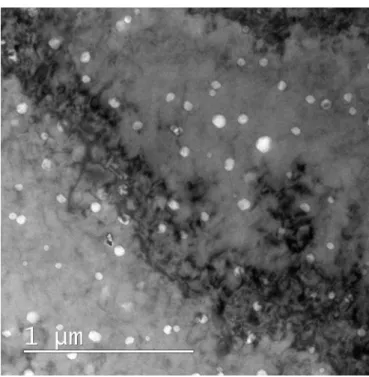HAL Id: cea-02442320
https://hal-cea.archives-ouvertes.fr/cea-02442320
Submitted on 16 Jan 2020
HAL is a multi-disciplinary open access
archive for the deposit and dissemination of
sci-entific research documents, whether they are
pub-lished or not. The documents may come from
teaching and research institutions in France or
abroad, or from public or private research centers.
L’archive ouverte pluridisciplinaire HAL, est
destinée au dépôt et à la diffusion de documents
scientifiques de niveau recherche, publiés ou non,
émanant des établissements d’enseignement et de
recherche français ou étrangers, des laboratoires
publics ou privés.
Experimental assessment of nanovoids growth
P.-O. Barrioz, J. Hure, B. Tanguy
To cite this version:
P.O. Barrioz, J. Hure, B. Tanguy. Experimental assessment of nanovoids growth. ICTAM 24th
-24th International Conference of Theoretical and Applied Mechanics, Aug 2016, Montreal, Canada.
�cea-02442320�
XXIV ICTAM, 21-26 August 2016, Montreal, Canada
EXPERIMENTAL ASSESSMENT OF NANOVOIDS GROWTH
Pierre-Olivier Barrioz
∗1, J´er´emy Hure
1, and Benoˆıt Tanguy
11
CEA Universit´e Paris-Saclay, DEN, Service d’ ´
Etudes des Mat´eriaux Irradi´es, 91191 Gif-sur-Yvette cedex,
France
Summary The growth of nanovoids in crystalline metallic material is assessed experimentally as a function of the applied macroscopic plastic strain, stress triaxiality and crystal orientation. Nanovoids - of diameter ranging from 20 to 80nm - are generated by performing heavy-ion irradiation on austenitic steel, leading to a model material constituted of a well-defined nanovoids distribution. Pre- and post-straining Transmission Electron Microscope (TEM) observations allow to quantify the growth and the evolution of aspect ratio as a function of plastic strain. Size and crystal orientation effects are evaluated. Experiments are compared to the results of crystal plasticity finite element simulations.
BACKGROUND
Numerous theoretical and numerical studies have been conducted to assess the growth of nanovoids under mechanical loading [1], showing size effects (the lower the size of the void, the lower the growth rate), crystal orientation effects (growth rate depending on the crystallographic orientation) and describing dislocation mechanisms involved as a function of the applied macroscopic stress. However, very limited experimental data are available in literature, and only for high strain rates / high applied stress. Thus the aim of this study is to assess experimentally nanovoid growth in the low stress regime, as a function of applied strain, stress triaxiality and crystal orientation.
EXPERIMENTAL INVESTIGATIONS
Nanovoids are usually observed in metallic materials under irradiation in nuclear power plant. These voids come from in-teractions between high energy particles and atoms of the material, that generate point defects ultimately leading to nanosized defects [2]. Irradiation is therefore used here to generate well-defined distributions of nanovoids, creating a model nanoporous material. Ionirradiation was performed at the JANNuS facility [3] on austenitic steel (316L), leading to spherical nanovoids -of diameter ranging from 20 to 80nm - in high density (Fig. 1), observed with Transmission Electron Microscope (TEM). As void growth under mechanical loading is very sensitive to stress triaxiality [4], tensile and biaxial tensile samples were used in this study. Post to irradiation, specimens were strained up to different levels of macroscopic plastic strain. Quantification of the evolutions of void size and aspect ratio as a function of plastic strain and crystal orientation, for different stress triaxiality, was done using TEM observations (Fig. 2).
RESULTS AND DISCUSSION
Nanovoid deformation under mechanical loading is shown to be sensitive to crystal orientation, as predicted by numerical and theoretical predictions: for some orientations, the void aspect ratio stays close to unity, while very elongated voids have been observed for other orientations (Fig. 2). The evolution of void size and aspect ratio as a function of plastic strain is studied as a function of applied strain, for some crystal orientations. Results are finally compared to predictions of finite elements simulations using crystal plasticity constitutive equations.
References
[1] Chang H-J, Segurado J, de la Fuente R, Pab´on B M, Llorca J, Modelling Simul. Mater. Sci. Eng. 21, 2013. [2] Zinkle S J , Was G S : Materials challenges in nuclear energy, Acta Mat. 61:735-758, 2013.
[3] Beck L, Serruys Y, Miro S, Trocellier P, Bordas E, Leprˆetre F, Brimbal D, Loussouarn T, Martin H, Vaubaillon S, Pellegrino S, Bachiller-Perea D: Ion irradiation and radiation effect characterization at the JANNUS-Saclay triple beam facility, J. Mater. Res. 30:1183-1194, 2015
[4] Segurado J, Llorca J : An analysis of the size effect on void growth in single crystals using discrete dislocation dynamics, Acta Mat. 57:1427-1436, 2009.
Figure 1: Spherical nanovoids observed by Transmission Electron Microscope (TEM) after ion-irradiation in austenitic steel
Figure 2: Nanovoids observed by Transmission Electron Microscope (TEM) in ion-irradiated austenitic steel after straining to 30%
